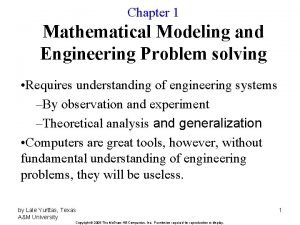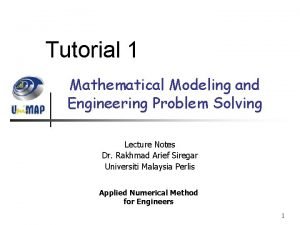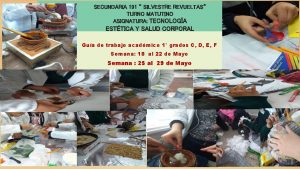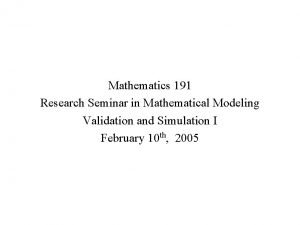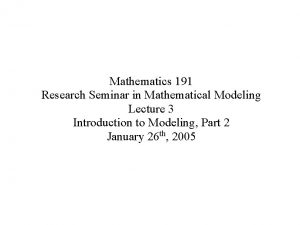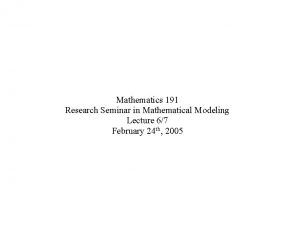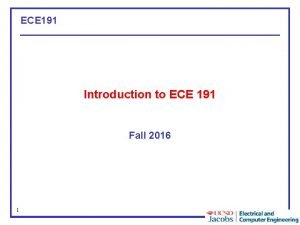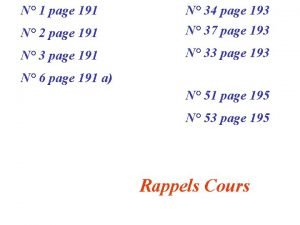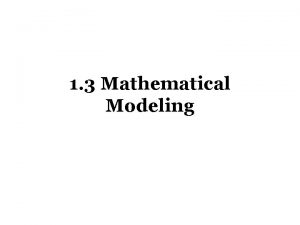Mathematics 191 Research Seminar in Mathematical Modeling 28










- Slides: 10

Mathematics 191 Research Seminar in Mathematical Modeling 28 March 2005 Rapid Modeling and Tractability

Today's class: How do we build mathematical models in a compressed time-frame? I was concerned to hear last time a lot of uncertainty about whether or not it was possible to model a large number of systems. I feel like the reason this happened is that although we've spent a good deal of time talking about how to model, and we usually have one or two abortive modeling sessions during a class period, we haven't spent much time creating and presenting complete models and working out entire solutions to the problem.

First, a timeline for final projects: March 15 -27: Background research (10 -15 hours) Check journal databases to get up to speed on scholarly work in your field. March 28 – April 2: Build model (10 -15 hours) Follow the process we’ve outlined so far. April 3 -10: Write up your model so far. Code a simulation or other numerical evaluation. [Evaluations]. April 11 -18: Collect or generate data. Use the simulation to assess the effectiveness of your model or solution. Analyze results. April 19 -26: Write up model. Use existing papers you find during your literature search or previous years’ MCM winners as a template. [Evaluations] April 26 -May 1: Prepare Power. Point presentations. Rehearse. Put the finishing touches on your model paper. [Evaluations] May 2 -7: Prepare your paper for publication. Research appropriate journals. Consult with your faculty advisor and potentially your reader. [5 -10 hours] May 8 -13: Present.

Background Research March 15 -27 Check journal databases to get up to speed on scholarly work in your field. Has your system or problem already been modeled? If it has, what new aspect of the problem will you be addressing? How accurate are present models? What assumptions do they make, and how can you improve upon them? What kind of mathematics have been used in current systems? What mathematics will you use to model your system? You must have a faculty advisor at this point for your project. Sit down with this person and discuss the problem you have chosen. Aim to meet with this person about once per week from here on.

Model Construction March 28 – April 2 Follow the process we’ve outlined in the class so far as closely as possible. This structure for addressing a problem will ensure that you are successfully able to construct a model. Above all else, use common sense and existing knowledge to guide the construction of your mathematics. Use your intuition about how a system should behave, and then translate those systems into mathematical statements using mathematics you are familiar with. If you are unable to learn a mathematical method rapidly enough to make good use of it, either don’t use it, or put it off for a more advanced model. A model that you understand completely, even given weaknesses, is superior to a model using mathematics you can’t understand.

Model Writeup and Computer Model April 3 -10 Write up the model that you have so far. You should have a complete paper at the end of this week, minus validation, analysis, and conclusions. Present your write-up in class for evaluations and updates. Code a simulation or other numerical evaluation. Test your simulation on several cases to make sure it’s doing what you expect. If you can’t finish your simulation in this time frame, then your simulation is too complicated and you must simplify it.

Data and Model Analysis April 11 -18 Finish testing your simulation or numerical evaluation. Collect the necessary data to plug in to your simulation, or generate simulated data. Use the simulation to assess the effectiveness of your model or solution by the criteria you have established. Analyze the strengths and weaknesses of your model. Lay out future areas for expansion. Comment on as many aspects of your real-world problem as intelligently possible.

Recall the modeling process we’ve established in this class. Write up a complete solution to the following problem. We will present our complete findings in the last twenty minutes. Put together a brief ~5 minute presentation to demonstrate your results. Make sure to present all aspects of the problem as stated in the modeling process and to answer all questions asked in the problem. Follow the iterative aspect of the process closely. Start out with the simplest model possible (using many broad assumptions) Your absolute top priority needs to be to create a finished model within the time frame allotted. This means you will have to write a schedule for your time over the next hour and stick to it closely. You do not need a simulation for this problem [not all models do]. You do, however, need to propose a complete method by which you would be able to validate your result, and outline the steps by which you would be able to gather any data you need. Use the computer lab next door to grab likely values for parameters.

The Modeling Process ● Statement of Problem (abstraction) ● Define Model Objective / Objective Function ● Definitions and Identification of Variables (background research and common sense) ● Assumptions (for tractability) ● Establish Informal Relationships Based on System ● Construct Mathematical Statements ● Construct Base Model ● Estimate Parameters ● Apply Mathematical Methods ● Pure Mathematical Solution ● Simulation and Validation (the inverse of the abstraction process) ● Sensitivity Analysis ● Relax Assumptions ● Iterate ● Assess Model Limitations

Paper or Plastic? The choice between placing groceries in paper or plastic bags in the checkout aisle may seem insignificant to a company's bottom line. However, over hundreds of thousands of transactions, the cost difference between bag types may have a significant effect on a company's profit margins. The desire for a grocery store to keep bagging costs low is offset by the need to keep customers satisfied. If bags break in transit or are arranged so as to damage groceries, customers are likely to be unhappy. In this problem, you will model the significance of the check-out strategy for a grocery store's profit. As consultants to a large grocery chain, your team has been asked to develop a procedure for the stores' grocery baggers to use while bagging a customer's groceries. Recommend an optimal bagging strategy for grocery store employees to use in order to minimize cost and disruption to customers and maximize longterm profit. Include in your model customer satisfaction, bag strength, and the length of time needed to bag groceries. Include in your recommendation an answer to the question of when plastic or paper bags should be used.
 Helen c. erickson nursing theory
Helen c. erickson nursing theory Relational vs dimensional data modeling
Relational vs dimensional data modeling Mathematical modeling of electrical systems examples
Mathematical modeling of electrical systems examples Mathematical modeling and engineering problem solving
Mathematical modeling and engineering problem solving Mathematical modeling and engineering problem solving
Mathematical modeling and engineering problem solving Mathematical economics vs non mathematical economics
Mathematical economics vs non mathematical economics Difference between mathematics and mathematical literacy
Difference between mathematics and mathematical literacy Ece 191 ucsd
Ece 191 ucsd Secundaria 191 silvestre revueltas turno matutino
Secundaria 191 silvestre revueltas turno matutino Iso 191
Iso 191 Morbus paget
Morbus paget



